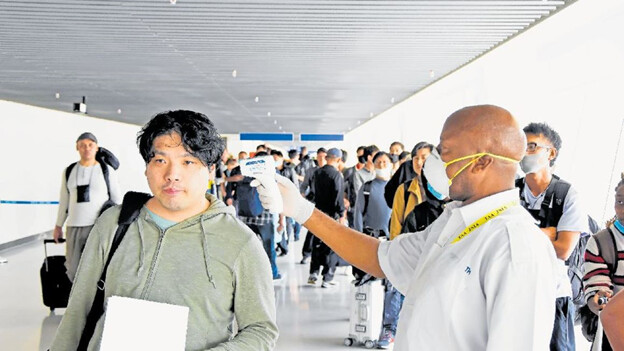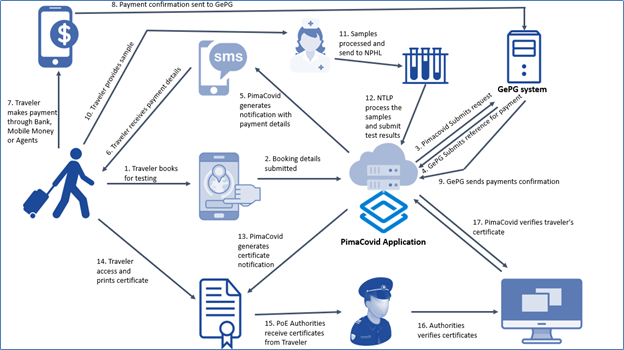
Figure 1: Travellers checked for temperature at JK International Airport
When COVID-19 broke out in late December 2019 and subsequently declared a Worldwide pandemic in early 2020, few could envision its impact a year on. It has not only changed how we socialise but how we travel abroad. Throughout the world, the public and private sectors have adopted digital services and infrastructures to support their healthcare services and cope with the pandemic economic impacts. The latest WHO Covid-19 Travel Advice for international travellers has argued for countries to continue taking strict measures to control the outbreak as they gradually lift the imposed travel restrictions. For example, Laboratory PCR testing should be conducted immediately before departure or on passengers’ arrival as the results may provide information about travellers’ status.
Like many other countries globally, Tanzania imposed sweeping measures to control the outbreak, such as travel bans, the prohibition of mass gatherings, and build capacity at its Points of Entry (PoE). As the country started re-opening its international borders, i.e. air, sea, and land, travellers were required to test and receive a negative certificate immediately before beginning their journey. At the time, travellers had to provide their samples at the National Public Health Laboratory (NPHL) in Dar es Salaam and receive a printed control number for payments. Test results were physically collected at the NPHL as printed COVID-19 certificates. At the PoE, such as airports, health officers inspected the certificates and permitted passengers with negative COVID-19 certificates to travel abroad.
However, this process had several challenges to travellers and the government. For example, travellers from other regions across the country had to come to the NPHL and provide samples and collect their certificate. In addition, the government noted an emerging problem of forged COVID-19 certificates in the community. A digital solution was thus, proposed whereby the Information Communication and Technology (ICT) unit within the Ministry of Health, Community Development, Gender, Elderly and Children (MoHCDEC) partnered with e-Government authority and the Department of the Computer Science and Engineering at the University of Dar es Salaam (UDSM) and HISP Tanzania to develop a PimaCovid application ( https://pimacovid.moh.go.tz/ ). The application was developed under the existing National Health Information Systems (HIS) platform, i.e. District Health Information Software 2 (DHIS 2). The national HIS is owned and managed by the MoHCDEC, with technical supported provided by UDSM and HISP Tanzania. The e-Government has implemented a Government electronic Payment Gateway (GePG) facilitating electronic money transactions from the public to the government and vice versa.
The “PimaCovid” application facilitates travellers to book sample collection appointments from more than 64 facilities across the 27 regions in Tanzania mainland and Zanzibar. Once the appointment is confirmed, a traveller receives a notification via SMS and an email. The notification includes details of the booking and a control number generated from GePG for payment through mobile payment, mobile money agent, or bank transfers. When payments are made, GePG communicates automatically with the “PimaCovid” application allowing health workers to collect the traveller’s sample, process and transfer them to the NPHL for COVID-19 testing.

Figure 2: Process flow of usage of PimaCovid app for booking and certificates verification
Within 24-48 hours from sample collection (depending on where the sample was taken), travellers receive a notification via SMS and an email informing them to check their results at the PimaCOVID application. Those with negative results receive a digital COVID-19 certificate and continue with their travel plans wherever they are. Health officers at the PoE verify travellers’ certificate by accessing the PimaCovid application using computers or tablets. However, passengers with intermediate results are encouraged to follow the health protocols stipulated by the MoHCDEC.
The implementation of PimaCovid has facilitated the government’s plans for decentralising sample collection centres, enabling travellers to easily book and provide samples from every corner of the country. For example, the system records more than 5,800 bookings per week from 64 facilities across the country. In addition, travellers can access their certificates anywhere after receiving notification from the “PimaCovid” application. The verification process of the certificates through the “PimaCovid” application ensures that travellers with only negative certificates are permitted to travel outside the country, contributing to the efforts of curbing the ongoing pandemic.
The information exchange between the “PimaCovid” application and the Government electronic Payment Gateway (GePG) has allowed travellers to complete payments with a range of options such as mobile payment, mobile money agent, or bank transfers. In addition, this innovative data exchange has extended the “PimaCovid” application and DHIS2 by its extension to handle laboratory and financial processes such as management of sample and testing results, financial data reconciliations, and printing of travellers’ receipts.
In general, the implementation of the “PimaCovid” application has strengthened the efforts made by MoHCDEC to control the pandemic and respond to global travel advice. The application has significantly reduced the passengers’ movements in securing negative COVID-19 certificates before travelling abroad. Furthermore, the application has helped decentralising COVID-19 testing centres in Tanzania, lessening crowds at the NPHL.